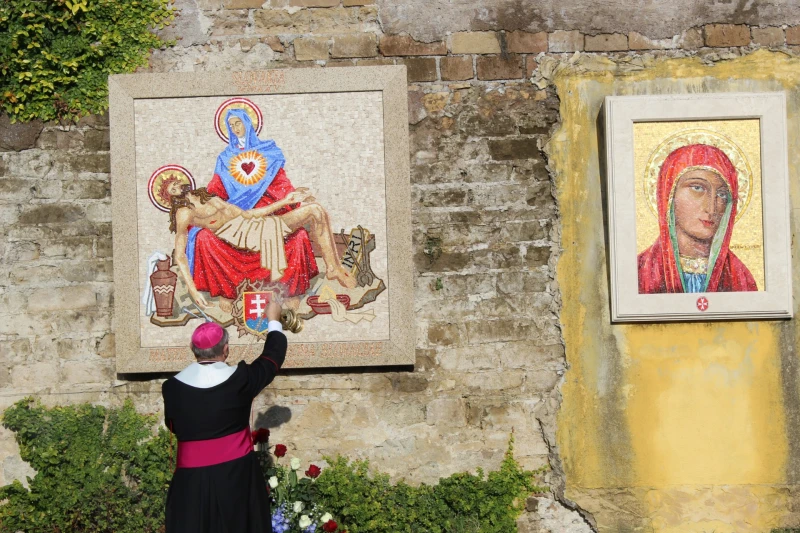Cardinal Jean-Claude Hollerich, the relator general of the 16th Annual General Assembly of the Synod of Bishops. / Daniel Ibáñez/CNA
ACI Prensa Staff, Oct 13, 2023 / 15:52 pm (CNA).
Speaking at the Synod on Synodality, Cardinal Jean-Claude Hollerich shared an introductory reflection on the “co-responsibility of the mission.” This is the subject of the third module, dedicated to section B2 of the Instrumentum Laboris, or working document, which is being addressed starting today.
B2 reads: “Co-responsibility in Mission: How can we better share gifts and tasks in the service of the Gospel?”
In his reflection, the relator general concluded that “in this module we touch on some of the key points of our synod” and thus asked those present not to give “hasty answers that do not consider all the aspects of these difficult questions.”
In this regard, he added: “We have theologians we can consult, and we have time to pray and delve into the issues we identify” in order to reach a conclusion in the second session in October 2024.
At the beginning of his talk, he noted that “as we have already learned, each section, and therefore, each module, has a title, accompanied by a question, which shows us where to focus our attention in order to avoid getting lost.” Then he added jokingly: “It’s not good to get lost in the catacombs and it’s not good to get lost in the synod.”
The cardinal also stressed that “communion does not close on itself but is impelled towards mission. At the same time, the purpose of the mission is precisely to extend the scope of communion, enabling more and more people to meet the Lord and accept his call to be part of his people.”
Co-responsibility in the mission
Hollerich referred to the internet as “a mission territory” in which the Church must be guided “by the people who inhabit the digital continent,” because, he acknowledged, “mostly we bishops are not the pioneers of this mission,” although “some are very good at it.”
He offered this example to illustrate the meaning of co-responsibility in the mission: “All the baptized are called and have the right to participate in the mission of the Church, all have an irreplaceable contribution to make.”
“This is the horizon within which the five worksheets for Section B2 are placed,” he explained. Points B2.1 and B2.2 refer to “How can we walk together towards a shared awareness of the meaning and content of mission?” and “What should be done so a synodal Church is also an ‘all ministerial’ missionary Church?”
Regarding point B2.1, Hollerich pointed out that “to the mission of the Church belongs the commitment to integral ecology, the struggle for justice and peace, the preferential option for the poor and the peripheries, and the willingness to be open to encounter with all.”
As for B2.2, he only announced that some testimonies would be heard in this regard.
However, he elaborated on the following three points, understanding that “an assembly like ours needs to be very careful when dealing with them.”
These questions (B2.3, 2.4, and 2.5) concern how to give “greater recognition and promotion of the baptismal dignity of women”; “How can we properly value ordained ministry in its relationship with baptismal ministries in a missionary perspective?” and “How can we renew the service of authority and the exercise of responsibility from a missionary synodal perspective?”
For the relator general, “all the themes of the Instrumentum Laboris concern us closely and touch us. But these three do so in a particular way” since ”each of us is the bearer of a point of view that is essential, but to address the themes effectively, we are also called to realize our own partiality.”
Regarding the baptismal dignity of women, he stressed the fact that “most of us are men,” adding that “I never read anywhere that the baptism of women is inferior to the baptism of men.”
On the question of ordained ministry, he noted that the majority of those present in the Paul VI Hall, “besides being men, most of us are also ordained ministers.”
In this regard, he shared: “What is the relation between ordained ministry and other baptismal ministries? We all know the image of the body St. Paul uses. Are we ready to accept that all parts of the body are important?”
Thirdly, in reference to the proposed reflection on the episcopal ministry, the cardinal asked how it should be “renewed and promoted in order to be exercised in a manner appropriate to a synodal Church.”
The answer to this question “will have a direct impact on our everyday lives, on the way we manage our time, on the priorities of our agenda, on the expectations of the people of God towards us, and on how we conceive our mission,” he explained in reference to the bishops.
Difficulties in the small circles
Before concluding, Hollerich pointed out that “the facilitators report that, on average, small circles have a harder time during the second round” when “each person is called upon for a moment to put aside their point of view, their own thinking, in order to pay attention to the resonance that listening to others evokes within them.”
The cardinal clarified that it is “an opportunity to be open to something new, something we may never have thought of in that way. This is the gift the Spirit has in store for each of us.”
Furthermore, he noted that in general congregations “free interventions should express the resonances with the insights shared by the groups.”
For this reason, he asked the facilitators of the small circles to “present the points of convergence and divergence, but above all the questions to be explored and the proposals for concrete steps to be taken during the coming year.”
This story was first published by ACI Prensa, CNA’s Spanish-language news partner. It has been translated and adapted by CNA.











